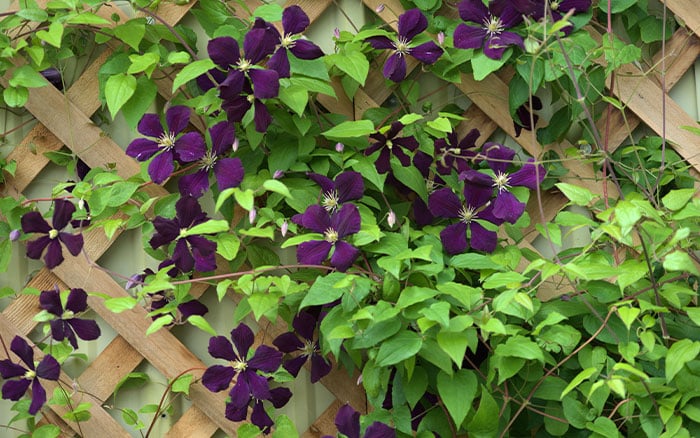Climbers are a great addition to any garden, because adding height always adds extra interest. Tie in your climbers with these tips.
As well they help to prolong or extend the flowering season. Most of them really do benefit from being tied into their support structure in some way – whether they are short, medium, or tall.
It’s always best done before the plant starts its current season’s growth and becomes a jumble of leaves!
Tying in before the leaves grow means you can easily see where you want to train the stems. It will make life easier because it’s really difficult to untangle stems once they get their growing spurt on.
Plus, the later you leave it, the more you risk damaging or knocking off the developing flower buds.
A visual reason for tying in stems early, especially with roses and other woody stem climbers, is that the arrangement will look more natural if done early.

However, if you wait until the plant has started growing again you could potentially end up with stems that have started growing at their natural angle.
Then when you tie it in you are effectively forcing the stem into an unnatural angle, which could look odd when compared with the natural angle below it.
Materials to use

The golden rule is to never use wire! That includes wire that is covered with a layer of plastic.
As the plant’s stems thicken, the wire cuts into the stem which could result in killing it. This happens if the plant is unable to send food up and down it, hindering its growth and flowering.
String is an acceptable alternative but choose a tough one for longevity. Pure plastic ties are flexible and long lasting, but try to find a brand made entirely, or a large percentage of it, from recycled plastic.
Whichever material you use, don’t tie too it too tightly to the stem. You’d be amazed how much width growth a stem can put on in a growing season.
Give some thought to the colour of the material. Some companies sell beautifully coloured twine or bright shades of green plastic ties but remember that they won’t blend in with the plant.
How to tie in climbers
When working at a height, ensure the ladder is safely anchored on the ground. If necessary, ensure you have somebody standing on the bottom rung to keep it stable.
Tripod ladders are really stable alternatives to traditional two-foot ones. However you may still need someone to stand on the bottom rungs if you’re having to climb to a great height.
Prepare by pre-cutting lengths of string/plastic before going up the ladder. It’s safer and one less thing to have to try and do when working above ground.

Make sure that what you’re tying into is solid. It’s easy to fail to spot that a wood trellis has silently rotted to the point of collapse because of the covering of stems over it. So, first check that the structure the climber is growing onto or over is still sound and fit for purpose.
If you’re tying in for the first time, think carefully about how you want your climber to look over the years as once you’ve started it’s quite difficult to start again.
Another good tip is to tie the string or plastic to the form of support or attachment first. Then tie round the stem as it gives it better protection from rubbing against what it’s been attached to.
If tying in your climber to a system of wires, consider adding tensioners. These will help keep the wires taut, because there’s nothing worse than looking at saggy wires.
Alternatively, a cheap, easier option to using wires, is to attach to rust proof screws or vine eyes. When growing up a brick wall it’s often easier to fix the screws into the pointing. Use screws that are around 5cm-7.5cm long to give enough protruding length to tie into.
Then, simply tie the stem to the screw. This also works on fences but ensure the screws are attached to the posts.
Lookin’ good

If training woody stem climbers, vary the angle of stem placement to create a fan shape, with the middle stems upright and the side ones grading out either side.
If you want formality, then space each stem with the same width gap in between. It’s a good idea to have a piece of cane or stick cut to the desired width to save you grappling with a tape measure, especially if halfway up a ladder.
Once finished it’s a good idea to check the ties periodically during the growing season that they are holding firm and not cutting into the developing stems.

Leave A Comment